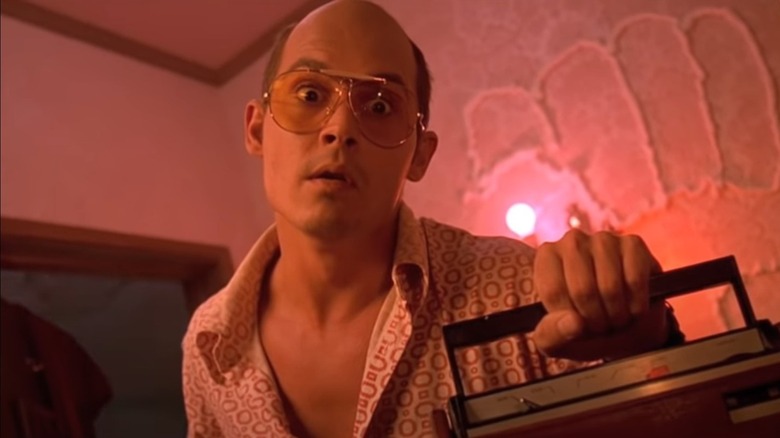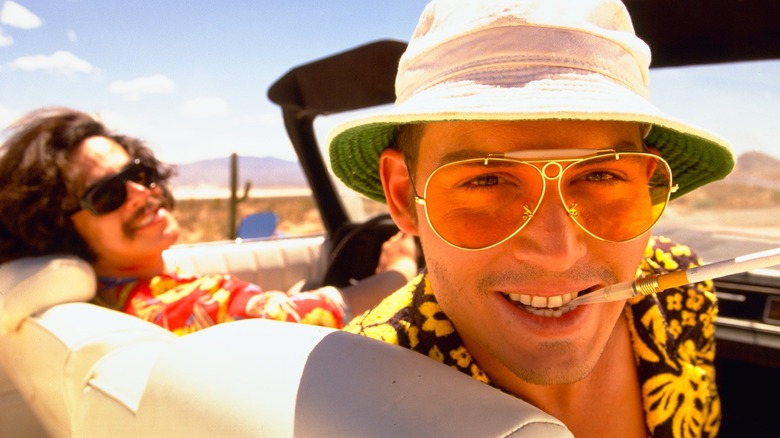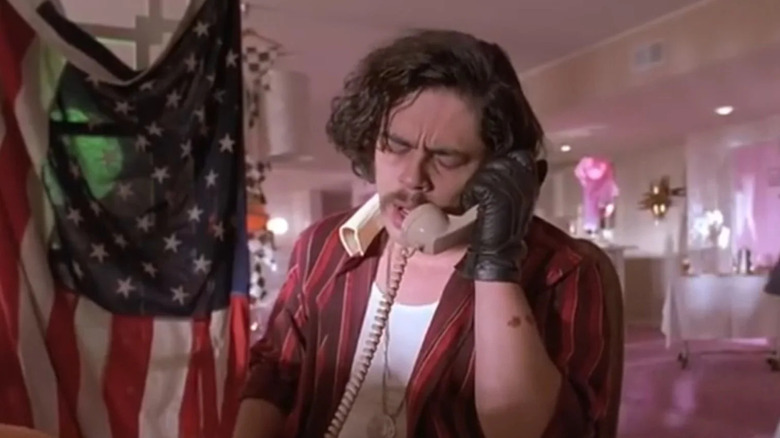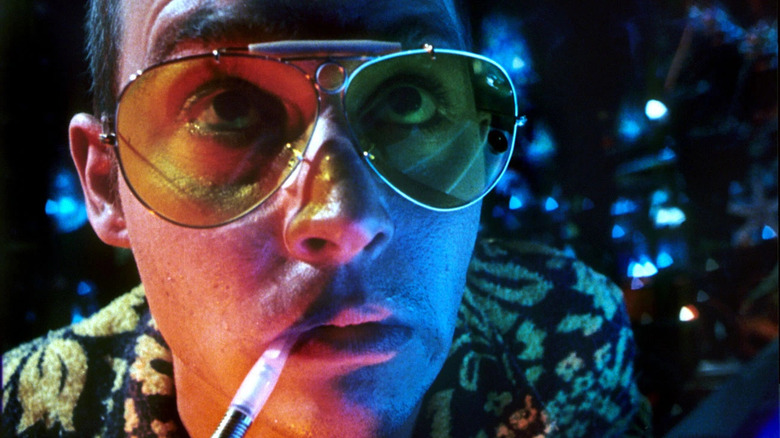Terry Gilliam's Time On Fear And Loathing In Las Vegas Was More Mundane Than The Movie Makes It Seem
Hunter S. Thompson was my favorite writer when I was in my early 20s, and I really bought into the idea of gonzo journalism. Thanks to "Fear and Loathing in Las Vegas" and "The Kentucky Derby is Decadent and Depraved," I interpreted it as this: Take a trip somewhere, get wasted, indulge in some wild and crazy s***, then write about it. I was pretty good at the wild and crazy part back then, but the problem was that I forgot to actually write anything. When I did occasionally get around to putting pen to paper, I found myself aping Thompson's style way too much.
I was over my Hunter Thompson obsession by the time Terry Gilliam's "Fear and Loathing in Las Vegas" hit our screens in 1998, but I still couldn't see how it played out. For me, Ralph Steadman's aggressive illustrations were as inseparable from the text as Tenniel's engravings for Lewis Carroll's "Alice in Wonderland" tales, yet the former Monty Python star's uniquely cock-eyed style seemed perfectly suited to the material.
The result was just about as good as anyone could have expected considering the book's unfilmable reputation, but it flopped at the box office and critics were far from impressed. By turns exhilarating and exhausting, Gilliam's film was a pretty faithful adaptation. It was a two-hour barrage of trippy visuals held together by the demented performances of Johnny Depp as Thompson's alter-ego and Benicio del Toro as his grotesque lawyer. It has since become a stoner classic, but you certainly don't need to be high or even mildly tipsy to feel intoxicated by the insane imagery. You might think such wall-to-wall madness on screen must have been the production of a wild shoot, yet Gilliam's approach was far from gonzo.
What happens in Fear and Loathing in Las Vegas again?
It is 1971 and writer Raoul Duke (Johnny Depp) has received an assignment to cover the Mint 400 off-road motorbike race in the desert outside Las Vegas. His shady attorney Dr. Gonzo (Benicio del Toro) advises him that he will likely need legal counsel before the story is put to bed, and the best approach is to acquire a very fast convertible, Acapulco shirts, and a vast array of drugs.
They gather their supplies and speed across the desert towards Vegas, spaced out of their skulls and hallucinating about giant bats. This sets the tone for the whole trip as they trash their hotel room, aggressively alienate everyone they meet, crash a police convention about drugs, terrorize a waitress, and get involved in many other anti-social shenanigans. It's not all leisure, though: Duke sees the race coverage as the jumping-off point for a far more important story tapping into the "American Dream in action."
The plot doesn't go much further than that, and we spend the whole movie watching Duke and Gonzo lurch from one outlandish situation to the next in a gaudy, acid-enhanced nightmare version of Las Vegas. While it is mainly a black comedy, the film does have something serious to say. Published in 1971, Thompson's book was full of disillusionment at the state of America during the Vietnam war and Richard Nixon's presidency. As Terry Gilliam observed as retold in a piece from Rolling Stone:
"Hunter wrote ['Fear and Loathing'] as if he was a war correspondent. It just happened that the bombardment was a self-bombardment, with drugs, and his brain was the battleground. And rather than going where real guns were being fired and real people were dying, he goes to the heart of America: Vegas. But he's reporting as if he's a front-line war correspondent."
A long journey from page to screen
Like "American Psycho," "The Naked Lunch," and "Trainspotting," "Fear and Loathing in Las Vegas" overcame its unfilmable reputation and made it to the big screen, even though it took a long time to get there. An adaptation was considered as early as 1976 and it was rumored that Jack Nicholson and Marlon Brando were in the frame to play Duke and Dr. Gonzo.
Martin Scorsese and Oliver Stone both tried to get their own versions off the ground, and it's interesting to consider what they would have done with Hunter S. Thompson's vision. Scorsese doesn't seem an obvious match, but if his sleazy, neon-drenched '70s New York in "Taxi Driver" serves as an indicator, he might have pulled it off pretty well. Stone, on the other hand, gave us "Natural Born Killers" and "U-Turn," which suggests that his take on "Fear and Loathing" would have been pretty hellish.
Alex Cox was attached to the project when Johnny Depp was first offered the part of Duke. If "Repo Man" is anything to go by, he could have been a good fit for the book's critique of America, but he fell out badly with Thompson and got fired from the project, leaving the door open for Terry Gilliam. The "Twelve Monkeys" director is largely regarded as a fantasist but he can get political, too. "Brazil," often considered his masterpiece, was a biting satire of capitalism and bumbling bureaucracy wrapped up in an outrageous visual style.
It's hard to think of many other popular directors at the time better suited to bringing "Fear and Loathing" to the screen, although, in my perfect-world scenario, I would have loved to see Alejandro Jodorowsky have a crack at it.
Gilliam said no to drugs
"Fear and Loathing in Las Vegas" is a full-on drug odyssey, with Duke and Dr. Gonzo hitting everything from cocaine and LSD to adrenochrome, extracted from the adrenaline glands of a live human being. Terry Gilliam employs every trick in his arsenal to put us inside the addled perceptions of the two protagonists, and it's easy to suspect that the director behind such crazy visuals must have some experience with mind-altering drugs. Yet while discussing the scene when a bar turns into an orgy of humping lizards, Gilliam remembered:
"I said I wanted to take acid when we finished filming because I'm a product of the '60s, I never took acid because I saw what it was doing to 2 million people I knew. And in the end, I never did, and yet most people assume this is the work of a drug-crazed lunatic. We were just people going to work in the morning, doing what was true to Hunter Thompson's book."
As for Johnny Depp, how did he get himself into Thompson's headspace? When it came to filming outrageous drug consumption like the scene when Duke huffs ether, he told the following to Rolling Stone:
"I did it straight... I remember Hunter telling me that ether was the equivalent of twenty-three bottles of wine in a quick sitting, so I might have had some wine... I can say honestly that I was very responsible as a human being in my approach to the preparation and the work on the character Raoul Duke. Very responsible."
No drugs were involved as far as the director or lead actor were concerned, but who would have needed them anyway? Entering the world of Hunter S. Thompson is a "strange torpedo" ride, whether you're off your nut or stone-cold sober.



